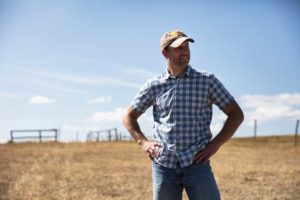Why agriculture matters — an angler’s perspective
Q&A with Scott Yates

Scott Yates, director of Trout Unlimited’s Western Water and Habitat Program, has worked for more than a decade with ranchers and farmers on water and conservation projects across the West. He shares his thoughts on pursuing conservation in working landscapes.
- Q. Why is agriculture important to a sportsmen’s conservation group like Trout Unlimited?
- A. In the West, it’s all about water—who controls it, who uses it—and most of the water rights are held and used by farmers and ranchers to grow food and raise livestock. Their operations have a big impact on watersheds and land health and, often, fish and wildlife habitat. Much of that impact is healthy—farms and ranches play a critical role in preserving open space and natural areas important to wildlife that would otherwise be damaged by development and other pressures. Further, most great western trout fisheries are located near rural communities dependent on agriculture – finding creative and innovative ways to meld conservation with sustainability in such communities is critical to long-term solutions and success.
- Q. Do farmers and ranchers care about trout and conservation?
- A. Conservation is important to most agriculture folks—they understand that taking care of the land and water is critical to their operations and their livelihood. Many ranchers and farmers rightly consider themselves the original environmentalists. It’s a tough way to make a living, though. Sometimes, they simply don’t have the resources to make big investments in new irrigation systems and other measures that would help advance conservation goals. And make no mistake, many ranchers and farmers grew up fishing the family property, or take kids or grandkids out on the back forty to do so today. They often notice changes in a fishery over time and help assess issues like fish stranded in a ditch or that end up on a field during high flows or other times of year. The key is to focus on solutions – because they’re out there – and not just play the blame game.
- Q. And that’s where TU comes in?
- A. That’s where we come in—we can partner with ag producers and help steer them to expertise and resources, like Farm Bill conservation programs, that they can use to improve their water infrastructure. For instance, we might help a farmer transition from an open irrigation ditch to a piped ditch—that efficiency might then allow them to leave some of the water in the stream to benefit flows and fish. If a new headgate is involved, it might allow them to actually close it tightly in the winter thereby leaving more water in the stream during a critical low flow period. They win, and the fish win. That’s the partnership model.
- Q. How is TU different from other conservation groups working in the West?
- A. One way we’re different is in hiring staff who live and work in the rural communities where we’re doing projects. Many of our staff have grown up or lived for a significant amount of time in the areas where they work and they understand the local resources and players. That helps us earn the trust of local farmers and ranchers—we’re not outsiders. Also, we have local grassroots chapters in many rural towns whose members have been doing conservation projects in the area for decades. TU is known and trusted—and that makes us effective partners.
- Q. How is TU hoping to make an impact given the huge challenges—drought, changing climate, wildfires—looming in the West?
- A. We’ve had a lot of success on the ground with projects like fish passage, fish screening, riparian restoration, and water use efficiency—and in recent years, we’ve dramatically ramped up the scale to take on entire watersheds and basins. It’s about putting the pieces back together, reconnecting the tributaries to the mainstems and restoring healthy flows. In the Upper Colorado River, we’re pursuing a basin-scale approach that requires partnerships and diverse expertise and resources brought to the table. Right now, we’re working with irrigation districts and individual producers to help them lease their water on a temporary, voluntary basis—they’re paid to voluntarily leave some of their irrigation water in the stream, so it can boost flows and storage levels in downstream reservoirs. It’s called the System Conservation Pilot Program, and we’ve demonstrated an exciting new market for ag producers while still ensuring the water rights stay attached to the land. We can achieve significant basin-wide water savings if we can get enough ranchers and farmers enrolled—and they’re very interested. That’s exciting. The solutions are out there. We’re working with our water partners to get it done.
- Q. What should anglers and sportsmen understand about agriculture producers?
- A. Too often, sportsmen see agriculture producers as hostile to their goals. That’s just wrong. We have a lot in common in our shared love for land and the outdoors and our desire to preserve what’s best about fish and game habitat and rural communities in the West. We need to work together—there’s a lot of low-hanging conservation fruit that we can pick together.
- Q. How can farmers and ranchers contact TU?
- A. Give me a call or shoot me an email about their ideas and questions – syates@tu.org. I’m always eager to hear from potential new partners and explain how we can work together.
Learn more about how TU works with farmers and ranchers on Farm Bill conservation programs.
